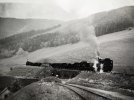On the question of whether bankers on the Lickey Incline were coupled to the train: for steam examples see:
. The sequences at 0:20 and 4:20 show that they weren't coupled to the train, and at 8:10 that they weren't coupled to each other either.
One thing I've never understood: how did the signalman at Blackwell know how many bankers to expect? He had to know they'd all passed his box before allowing another train into the block immediately below Blackwell. Did this depend on the banker, or the last banker of those on one train, showing a tail lamp (in addition to that on the train)?
On catchpoints (responding to
https://www.railforums.co.uk/threads/pilot-engines.264968/post-6714082): at 6:59 in
, the signalling diagram shows what I think are catch points about halfway up the bank, above the intermediate block signal. If I'm understanding the diagram correctly, they would have prevented any runaway on the upper half of the bank from running back into a following train.
At 2:40 in the Class 37 video (above,
https://www.railforums.co.uk/threads/pilot-engines.264968/post-6716097) you see a facing crossover which IIRC was installed when Bromsgrove station was reduced to a single platform on the up side. IIRC, catch points were installed on the up line just above this. I remember a non-standard diesel (possibly Kestrel on a test run?) running light engine but coming to halt just above the catch points. There was then a good deal of cursing and swearing as assorted railwaymen set about closing the points to allow a banker to rescue the failure.




